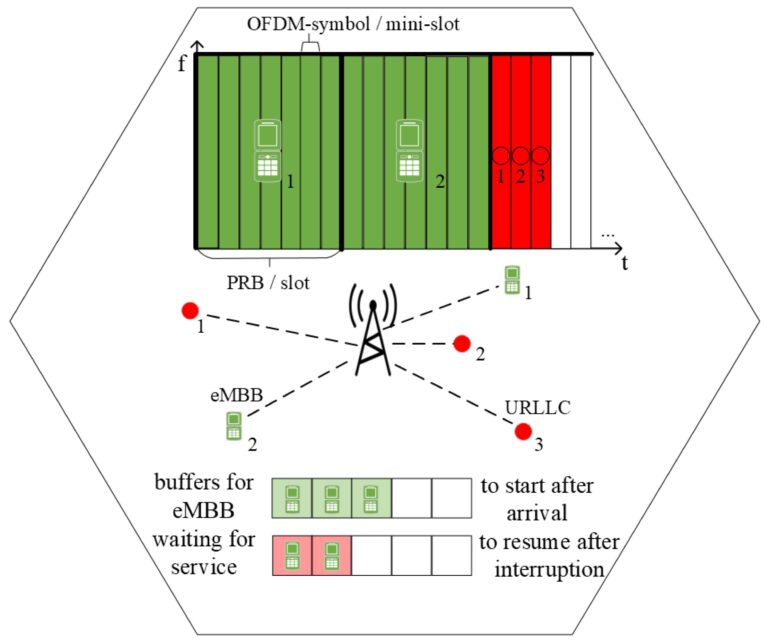× close
A scheme representing the system under consideration. The base station is in the center of the diagram. At the top of the diagram, the segments of the channel are displayed as a series of PRBs, with resources assigned to eMBB sessions highlighted in green and resources assigned to URLLC sessions highlighted in red. Towards the bottom section of the diagram, two base station buffers are shown, with the top buffer designated for new eMBB sessions and the bottom buffer designated for suspended eMBB sessions. credit: Math (2023). DOI: 10.3390/math11183925
Mathematicians from RUDN University have proposed a new scheme for 5G networks that optimizes access to different network segments. The number of non-priority tasks waiting to start or abort execution is halved, and the disconnect probability for that task is no more than 0.1%.The results will be published in a magazine Math.
The two main scenarios for 5G networks are Enhanced Mobile Broadband (eMBB) and Ultra Reliable Low Latency Communications (URLLC). eMBB first appeared on his 4G network, which offers massive data bandwidth and low latency. The 5G innovation is URLLC. This slice of the network transmits data very quickly. This allows you to implement applications of the Internet of Things, the Haptic Internet, and other emerging technologies.
Therefore, when URLLC and eMBB intersect, the former takes precedence. The quality of applications that use eMBB will be degraded.
Mathematicians from RUDN University have proposed a new scheme for allocating network resources so that URLLC is prioritized without losing eMBB.
“New usage scenarios require extremely high speeds, large numbers of connected devices, ultra-low latency and reliable applications. eMBB scenarios are human-centric and include access to multimedia content, services and data. .These need to cover large areas, high user density and high data transfer rates.
“The coexistence of multiple scenarios requires services with different quality of service requirements to be provided simultaneously. Therefore, the question arises of how to divide the frequency channels between URLLC and eMBB sessions. ” said Associate Professor Dr. Irina Kochetkova. said researchers from the Institute of Computer Science and Telecommunications at RUDN University.
Mathematicians used a classic scheme when sessions on eMBBB are interrupted when there are no resources left for URLLC. A new eMBB session is then submitted to the queue. Deferred and aborted sessions constantly check to see if resources have been released.
The authors refined this approach. Validation is not done all the time, but periodically. Additionally, “affected” eMBB sessions are waiting their turn in multiple locations. The new scheme differs from the previous scheme in that it consists of two “orbits,” or separate buffers for delayed and interrupted sessions.
RUDN mathematicians conducted numerical experiments to verify the effectiveness of the new scheme. Two separate buffers almost doubled the number of active eMBB sessions. At the same time, the probability of a connection failure is low, only 0.1%.
“This model guarantees graceful start and end and uninterrupted eMBB sessions. This scheme effectively reduces the average number of active eMBB applications while keeping the probability of interruption to less than 1 in 10 percent. Double it,” says Dr. Irina Kochetkova. said an associate professor at RUDN University’s Institute of Computer Science and Telecommunications.
For more information:
Elena Makeeva et al. Retry Queue System for Analyzing the Impact of Prioritized Ultra-Reliable Low-Latency Communication Transmission on Mobile Broadband Quality of Service Degradation in 5G Networks, Math (2023). DOI: 10.3390/math11183925
Science Project Provided by Lomonosov


